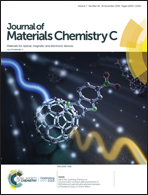Second-order nonlinear optical properties of [60]fullerene-fused dihydrocarboline derivates: a theoretical study on switch effect†
Abstract
Designing multi-state nonlinear optical (NLO) switch systems has been proposed aiming at the improvement of the multiple storage capacity of the optical memories. However, it is still a challenge to get high first hyperpolarizability (β) contrasts for the molecular second-order NLO switches. In this study, due to their rich electrochemical features, [60]fullerene-fused dihydrocarboline derivatives with a donor (D)–π–acceptor (A) electronic structure were studied for the second-order NLO response and switch effect via different computational approaches. The calculated results showed that significantly high contrasts were displayed on the tot values between the neutral and reduced states. Particularly, the system in which the substituent group was –NO2 had only a calculated βtot value of 0.6 × 10−30 esu, but one-electron reduction enlarged the βtot value to 5689 × 10−30 esu (evaluated at ωB97XD/6-31+G(d) level). Furthermore, the TDDFT calculations demonstrated that the large second-order NLO response of the reduced state resulted from the low energy absorption in the infrared region and the excitation transition from C60 to strong electron-acceptor.
![Graphical abstract: Second-order nonlinear optical properties of [60]fullerene-fused dihydrocarboline derivates: a theoretical study on switch effect](/en/Image/Get?imageInfo.ImageType=GA&imageInfo.ImageIdentifier.ManuscriptID=C9TC04126E&imageInfo.ImageIdentifier.Year=2019)


 Please wait while we load your content...
Please wait while we load your content...